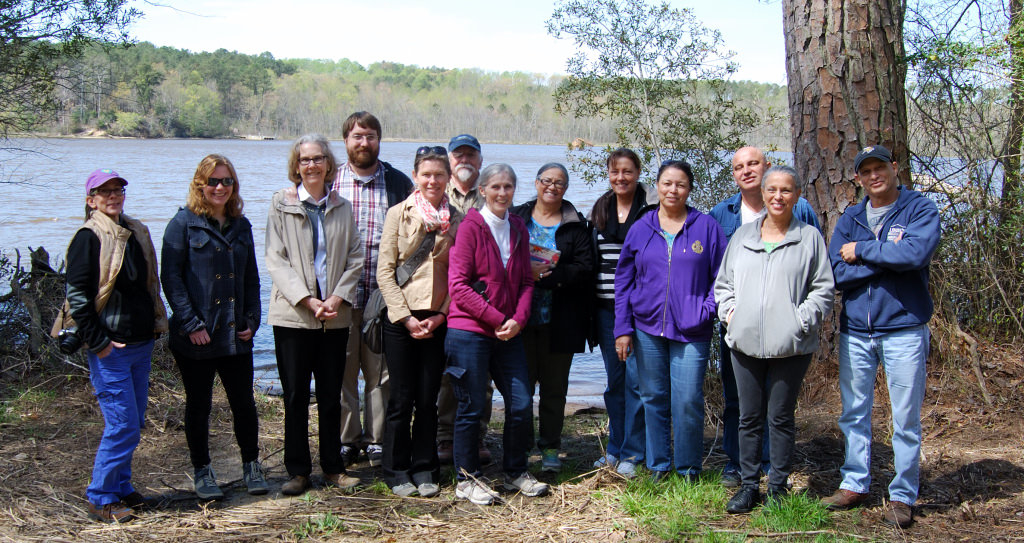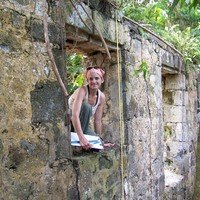
Dr. Julia King (third from left), collaborators, and project participants
St. Mary’s College of Maryland Professor of Anthropology Julia King was awarded a $240,000 grant by the National Endowment for the Humanities (NEH) to trace the history and development of the Rappahannock Indians in early American history (200-1850 AD) in collaboration with the Virginia Department of Historic Resources (DHR), Chesapeake Conservancy, and the state-recognized Rappahannock Tribe of Virginia. The grant was one of 245 humanities projects from across the country awarded a combined $39.3 million from the NEH.
The anthropology department at St. Mary’s College first began studying the Rappahannock River Valley’s history in 2016 at the request of the National Park Service Chesapeake Bay office with funds administered by the Chesapeake Conservancy. The work was undertaken to provide interpretive support for the Captain John Smith Chesapeake National Historic Trail.
Conventional wisdom has long held that the Rappahannock Indians moved to the north side of the Rappahannock River to escape the politically powerful Powhatan Indians in the York River Valley. Research by the St. Mary’s College team, however, suggests that ecological factors, including agricultural soils, marshlands, and clays suitable for pottery manufacture, and not political factors, better explain the Rappahannock’s decisions about where to settle. This discovery, which was made using Geographical Information Systems (GIS) technology, revealed the need for further archaeological study of the river valley. The NEH grant will allow this study on these tribal groups to continue.
Professor of Anthropology Julia King leads the research team, comprised of anthropology instructor Scott Strickland, an assistant archaeologist, and two archaeology technicians (St. Mary’s College undergraduate students) who will assist with field and laboratory work. They are joined by Chief G. Anne Richardson of the Rappahannock Tribe, who, along with tribal members, will assist with the field and laboratory work.
The continuing study will focus on the trajectories of movement into and within the Rappahannock valley, how the Rappahannock people used landscape and other forms of material culture to forge group and/or political identities between 200 and 1600 CE, and the reaction of the people living in the river valley to European contact and colonization.
“Thanks to the NEH grant, we will be able to start addressing some of the recommendations from the original study we conducted in 2016,” King said. “We hope to assemble a detailed culture history for the Rappahannock Indians in the river valley over the last 2,000 years, including archaeological collections-based analysis and a regional survey.”
Chief Richardson notes that her tribe’s oral history recalls the Powhatan as neighbors with whom they shared winter hunting grounds. “The Rappahannock’s history has been overlooked in almost every history book. We are grateful to the NEH for recognizing this serious gap in American history and providing the resources for us to address it.”
This research tracing the history and development of the Rappahannock indigenous cultural landscape is supported by the National Endowment for the Humanities. NEH supports research and learning in history, literature, philosophy, and other areas of the humanities by funding selected, peer-reviewed proposals from around the nation. Any views, findings, conclusions, or recommendations expressed in this press release, do not necessarily represent those of the National Endowment for the Humanities.
St. Mary’s College of Maryland is accredited by the Middle States Commission on Higher Education through 2024-2025. St. Mary’s College, designated the Maryland state honors college in 1992, is ranked one of the best public liberal arts schools in the nation by U.S. News & World Report. Approximately 1,700 students attend the college, nestled on the St. Mary’s River in Southern Maryland.



 Associate Professor of Religious Studies Betül Başaran recently completed a four-week seminar for college and university professors in Washington, D.C. Her seminar, titled “
Associate Professor of Religious Studies Betül Başaran recently completed a four-week seminar for college and university professors in Washington, D.C. Her seminar, titled “